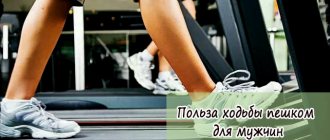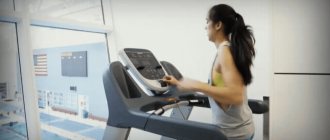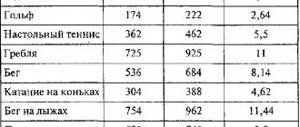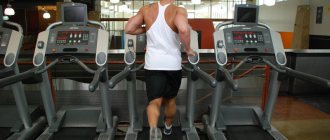What needs to be done to prevent an attack of arthritis from recurring and the disease to recede? Follow a diet. And what else? With the help of physical therapy, work on the rehabilitation of the affected joint - restore the maximum possible range of motion. To do this, it is necessary to improve the condition of the blood vessels, increase the strength of the muscles and ligaments around the affected joint.
In order to prevent and treat arthritis (arthrosis), the simplest and most effective physical exercise is proposed - walking .
“Brisk walking,” said Paul Bragg, “is the queen of physical exercise. No other exercise achieves such perfection in the work of coordinating muscles and the blood supply system as when walking.”
Therapeutic walking will improve the mobility of your joints, strengthen their muscular-ligament corset, strengthen the heart muscle, improve metabolism in the body and promote recovery.
You can start doing this type of exercise at any age. Main restrictions: first - the state of your health; the second and most important thing is your desire to get well.
Therapeutic walking - what is it?
We all walk certain distances every day at different paces, at different speeds for different periods of time. However, not everyone knows when a walk is beneficial and when it has no effect on the body’s condition. The fact is that there are three types of walking: normal, dosed and accelerated.
- Regular walking to some extent accelerates metabolic processes in the body, normalizes the functioning of the heart, blood vessels and respiratory organs, and stabilizes the psycho-emotional state.
- Dosed walking strengthens the cardiovascular system and trains the musculoskeletal system.
- Accelerated walking is characterized by increased energy consumption, a gradual increase in muscle mass and makes the human body more resilient.
Ordinary walking, as a rule, does not give a clear effect to healthy, physically fit people. For them, such loads are considered too light. But it helps elderly, weakened patients regain strength and smoothly transition to measured walking.
Useful tips for walking along the path of health
In sanatoriums, therapeutic walking, as one of the methods of physical therapy, is prescribed by the doctor.
But even if you decide to go on the path of health on your own and walk the entire route, this is unlikely to harm your body.
To begin with, it is recommended to master the easy route.
It is best to go for a walk in the morning, when there is no scorching sun, and special attention should be paid to equipment : shoes comfortable for walking; clothing appropriate for the weather. You can take clean drinking water with you. It is best to avoid eating a large meal before starting the route.
It is not recommended to carry hand luggage weighing more than one or two kilograms when traveling along the route. Even if it is a backpack, the load on your back cannot be avoided and the effect of walking along the path will be minimal.
It is not recommended to talk while walking on a health path (this interferes with breathing and reduces the flow of oxygen to the brain). If you decide to take a path route in a new area, then take into account the acclimatization factor.
The main indicator that the chosen route is suitable for you is smooth, unbroken breathing, absence of increased heartbeat and slight physical fatigue at the end of the walk. Landscapes that you can admire during a therapeutic walk have a beneficial effect on your psycho-emotional state.
Impact on the body
Despite the ease of implementation, therapeutic walking has a complex effect on human health. It improves the functioning of all body systems, from the respiratory system to the muscles of the legs. Let's highlight the main positive points:
- Normalization of respiratory function;
- Blood oxygen saturation;
- Strengthening the muscles of the limbs and body;
- Hardening;
- Increased immune defense;
- Improved coordination of movements;
- Toning the cardiovascular system;
- Increased endurance;
- Improving blood flow from the lower extremities, preventing edema;
- Activation of metabolic and energy processes;
- Weight loss;
- Increased stress resistance;
- Improved mood, psychological relief.
Thanks to such multidirectional effects, such training is prescribed for both therapeutic and preventive purposes. For healthy people, walking has a tonic and general strengthening effect, as a result of which they are less likely to suffer from viral infections and cardiovascular diseases.
Indications
Indications for dosed walking are equally varied:
- Bronchial asthma;
- Chronic obstructive pulmonary disease;
- Recovery after pneumonia;
- Metabolic diseases;
- Obesity;
- Osteochondrosis;
- Changes in blood pressure;
- Recovery period of stroke, heart attack, injuries;
- Vegetative-vascular dystonia;
- Pregnancy;
- Mental instability;
- Sedentary lifestyle.
Methods of therapeutic walking vary for the listed conditions; they must be agreed upon with a doctor. In particular, for bronchitis, osteoarthritis of the knee and hip joints, pregnancy, after a heart attack, stroke, coronary artery stenting, a leisurely pace of walking and a more gradual increase in loads are recommended.
Note!
Contraindications to dosed walking are acute infectious diseases, any decompensated pathologies of internal organs, acute stage of heart attack, stroke, pneumonia, etc.
Walking pace
For therapeutic purposes, you can walk at different speeds. The recommended pace depends on the patient's condition and initial physical fitness.
- A very slow pace is characterized by low speed - up to 70 steps per minute or 3 km/h;
- At a slow pace, the patient moves at a speed of 70-90 steps per minute. (3-4 km/h);
- By average pace we mean a moving speed from 90 to 120 steps per minute, which corresponds to 4-5.5 km/h;
- At a fast pace, a person walks at a speed of 120-140 steps per minute (or 5.5-6.5 km/h);
- Walking pace over 140 steps per minute. (6.5 km/h) is considered very fast.
As a rule, in the initial stages it is recommended to walk at your usual pace, and increase it every 3-5 days. However, this advice is not universal: it all depends on the condition of a particular person and his tolerance to physical activity.
Walking pulse
Pulse control is very important during any physical activity, and such a therapeutic and health-improving method as dosed walking is no exception. Counting your pulse before, during and after a walk helps to assess the adequacy of the chosen load, the body’s readiness for this kind of training and the functional state of the cardiovascular system. It is recommended to count your heart rate (HR) every 0.5-1.0 km.
Heart rate norms are individual and depend on many factors (the state of the nervous system, the efficiency of the heart, the initial physical fitness of the patient). On average, after a walk, the heart rate increases by 10-20 beats per minute. It should return to normal in no more than 10 minutes.
Heart rate rates directly during training can be approximately estimated according to the following scheme:
- Very slow tempo – up to 85 beats per minute;
- Slow – 85-95 beats per minute;
- Average – 95-120 beats per minute;
- Fast - 120-130 beats per minute;
- Very fast - 130-150 beats per minute.
Important!
If the pulse during the period of exercise becomes more than 150 beats per minute, then its intensity must be reduced.
At rest, the heart rate is 60-80 beats per minute. At the same time, it is necessary to take into account that in athletes and patients taking certain medications, it slows down, and in a number of diseases of the heart, respiratory system and endocrine glands, on the contrary, it accelerates.
Note!
If there is a heart rhythm disorder such as atrial fibrillation, the pulse measured in the radial arteries may be less than the actual heart rate. With this diagnosis, heart rate is calculated by placing the palm directly on the chest.
How to prepare for classes
Consult your doctor
Walking is suitable for absolutely everyone. But if previously your level of physical activity was zero, then your muscles, joints and heart will initially experience tension. Therefore, just in case, consult a therapist.
When you start walking, listen to your body. Pain, dizziness and nausea are signs that you are trying too hard. "If you experience chest pain, pain that radiates to your arm or neck, or severe headaches, stop and get checked by your doctor," says orthopedic surgeon Scott Mullen.
Buy quality sports shoes
Look for stores that provide gait analysis. This makes it easier to choose shoes that suit your foot type. Take a pair half a size larger than normal because your feet swell slightly during exercise.
Buy comfortable clothes
You don't need expensive sports equipment to practice walking, but you will be more comfortable in the right clothes. Choose items made from moisture-wicking fabrics, materials that have a little stretch and will not squeeze you when you move.
In cold weather, wear several layers of clothing to stay warm at the beginning of your workout, but easily remove excess clothing as you warm up.
Set yourself a realistic goal
“Take stock of where you're at—if you haven't exercised in a while, start with 10 minutes of movement a day,” says Erin Palinski-Wade, a registered dietitian and nutrition author. Increase your daily time by 5 minutes each week. This gradual approach will help your body adapt and reduce the risk of injury.
"If you're intimidated by long walks of 30 or 60 minutes, break them up into 10-minute chunks," Palinski-Wade continues. “You'll burn the same calories and get the same health benefits without having to change your routine.”
Start at a speed that is not too high. It should be such that you can easily say a few sentences on the go, but not carry on a long conversation. Gradually you will become more resilient and fast walking will be easier for you.
Prepare for muscle soreness
It’s quite natural that after climbing uphill out of habit, your shins will ache. This will go away when you start walking regularly. To get rid of discomfort, apply ice to the sore spot.
If the condition prevents you from walking or if not only your muscles, but also your joints ache, take a break for a day or two. If you feel pain right behind your kneecap, Achilles tendon, ankles or hips, you are overexerting yourself. Rest for a couple of days, applying ice to the aching areas. If this doesn't help, consult your doctor.
Keep a weight loss diary
Recordings will help you stay motivated and monitor your progress. Note how far you walk and how long it takes, as well as the incline if you're on a treadmill. Over time, you will begin to notice results. Not only in the number of kilometers traveled, but also in one’s own reflection.
Load levels
There are three levels of load during walking treatment:
- Gentle loads require a comfortable pace of movement at a speed of about 3 km/h. The walk lasts 60 minutes, during which time the patient stops to rest twice. Provided that the heart rate is stable, every three days the distance traveled is increased by 0.5 km, bringing the duration of the promenade to one and a half hours.
- Gentle training physical activity consists of walking at an average pace at a speed of 4.5 km/h for 1 hour. During this time, the patient makes two stops of 10 minutes each. During rest, he performs breathing exercises. Every two days the distance is increased by 0.5 km. By the end of the week, the duration of the workout should be at least 80 minutes, and the distance covered per day should be at least 6 km. After this, it is allowed to increase the pace of movement to 6 km/h under heart rate control.
- Training loads consist of daily walking at a speed of 6 km/h for 60 minutes. In case of fatigue, breaks are allowed during which the patient restores breathing. Their duration is variable.
Peculiarities!
Some conditions require more rest time. For example, walking with atherosclerosis of the lower extremities can cause intermittent claudication syndrome. At the same time, due to pronounced vasoconstriction, blood flows to the leg muscles in insufficient volume, and they begin to ache. In this case, patients are advised to walk more slowly and rest 2-4 times per walk.
Duration and frequency of training
The intensity of Nordic walking classes depends entirely on a person’s well-being and physical capabilities. The standard training regimen recommended by sports instructors includes at least 3 classes per week, lasting 1 hour.
The training program for beginners begins with 20-minute walks in the fresh air. Depending on the initial state of the body, the intensity of training should be progressively increased to the optimal level. You should not overwork yourself and bring yourself to a state of extreme fatigue. The loads during Nordic walking should be commensurate with the body’s capabilities.
To practice Nordic walking, you should choose places where there is a lot of vegetation and a minimum amount of transport: parks, groves and squares. This is the most favorable way to saturate the body with oxygen and recharge with vigor.









